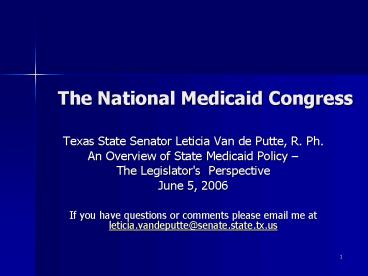The National Medicaid Congress - PowerPoint PPT Presentation
Title:
The National Medicaid Congress
Description:
Medicaid is rapidly surpassing as the number one spending category for state budgets. ... States want the flexibility and consistency in knowing from one-year ... – PowerPoint PPT presentation
Number of Views:24
Avg rating:3.0/5.0
Title: The National Medicaid Congress
1
The National Medicaid Congress
- Texas State Senator Leticia Van de Putte, R. Ph.
- An Overview of State Medicaid Policy
- The Legislator's Perspective
- June 5, 2006
- If you have questions or comments please email me
at leticia.vandeputte_at_senate.state.tx.us
2
Overview
- What is Medicaid?
- Is there a need for Medicaid reform?
- Is there a movement toward Universal Health
Coverage?
3
What is Medicaid?
- Medicaid has always been known as a safety net
for the poorest of the poor. - Medicaid was established so charity care and
public hospitals would not go bankrupt. - Today, due to the expansions in healthcare
Medicaid has become a tool to insure the
uninsured. - Medicaid is rapidly surpassing as the number one
spending category for state budgets.
4
Medicaid Facts
- According to the Congressional Budget Office, as
of August 2002, "Medicaid spending is expected to
rise by 18 billion, or 14 percent this year." - That rapid increase may be attributable to rising
costs for prescription drugs and greater
enrollment in Medicaid because of the sluggish
economy, the expansion of eligibility
requirements in some states, and increased
outreach efforts by states to recruit
participants. - In the past five years, Medicaid enrollment grew
when more people became eligible for the program
because of the economic downturn and the
reduction in employer sponsored insurance.
5
Healthcare Facts
- Today, states are the largest purchasers of
healthcare. - Medicaid beneficiaries are only one segment of
the healthcare population. - Other segments of the population to consider are
state employees, teachers, public university
employees, and the prison population. - Let's not forget that several of these segments
are made up of both active and retired employees.
6
What do states really want
- States want continued flexibility, measures of
quality, and best evidence. - There is often a constant tug within eligibility
classifications of Medicaid. - Long-term care advocates are often at odds with
folks who advocate for women and children's
issues. - Then there is also a tug between the providers of
institutionalized care and the community based
care providers. - States are continuing to debate many issues,
which in turn provides for the most heated and
passionate debates because of the unmet needs and
the cost of healthcare.
7
Why states like the Deficit Reduction Act of 2005
(DRA)
- States like the DRA because of the increased
flexibility and because states can tailor
coverage to fit the needs of each individual
state. - States want the flexibility and consistency in
knowing from one-year to the next whether or not
they have to be creative in plugging holes
created by the federal government. - If this is indeed a partnership we should not
have a directed and forced dialogue with our
federal compadres before anticipated changes are
made. - It is not a safety net anymore, CHIP and Medicaid
are an expansion of healthcare coverage as states
tackle trying to reduce the number of uninsured
with limited resources.
8
States who have utilized the DRA for Medicaid
Reform
- Kentucky
- Medicaid enrollees in Kentucky will be first in
the nation to have benefits customized to meet
their needs based on age and health status. - Prior to enactment of the DRA, states generally
could not target benefits to groups of enrollees. - Under the Kentucky plan, the state will offer
differing benefit packages aimed at meeting the
health care needs of different groups --
children, the elderly and people with
disabilities who need institutional care, and the
general Medicaid population.
9
Kentucky's Medicaid Reform
- The Kentucky plan also reduces enrollee cost
sharing from the current Medicaid program for the
Comprehensive Choices and Optimum Choices benefit
plans as follows - Medicaid enrollees will be required to pay a 10
co-pay per hospital inpatient admission. - Co-payments will not be required for physician
services, vision services, dental services,
chiropractic services and hearing and audiometric
services.
10
States who have utilized the DRA for Medicaid
Reform
- West Virginia
- W.Va. will offer enrollees a choice of two
benefit packages, a basic plan based on the
current Medicaid service package and an enhanced
package that includes benefits not traditionally
offered under Medicaid. - According to HHS Secretary Mike Leavitt, the
intent of the plan is to encourage Medicaid
beneficiaries to adopt healthy behaviors by
entering into a partnership with the state. - To enroll in the new advanced benefit package,
enrollees will be asked to sign a member
agreement with the state that they will comply
with all recommended medical treatment and
wellness behaviors. - Enrollees who chose not to join the enhanced plan
or who decide they do not wish to continue in it
will receive the standard Medicaid benefit
package.
11
Medicaid reform is a good step, but pursuing
universal coverage is better
- As of the 2004 Census Bureau count, there are
nearly 46 million Americans without health
insurance. - Bold legislation is necessary to address the
unmet healthcare needs in this county. - Maine and Massachusetts are moving toward
universal health care.































